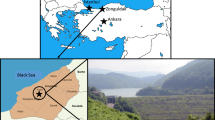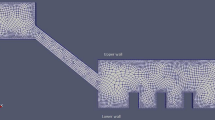Abstract
This paper focuses on the evaluation of temporal and spatial propagations of impulse waves using 3D numerical simulation-based models for a potential landslide area in the Tersun Dam reservoir, Northeast Turkey. The topographical model was created using Stereo Lithography files, and a drift-flux model was used to simulate the landslides. The wave generation was simulated using the Reynolds-averaged Navier–Stokes equations. The Drift-Flux approach was selected, and a renormalization group-based k-ε turbulence model was used to create a fluid–solid coupled model. The results show that a 16.5-m impulse wave is created as a result of sliding material hitting the water at a velocity of 16.4 m/s. The wave will reach the opposite shore in 27.4 s, and the run-up height will reach up to 48.8 m. As the wave, with an average velocity of 11.6 m/s in the reservoir, propagates toward the dam body, its height will decrease, and a 3.7-m-high wave will hit the dam in 155 s. A validation analysis performed using empirical equations and laboratory model tests indicates small differences in the results. The main reason for these differences is that the evaluation of wave properties is independent of the type of mass movement in empirical methods. A proper stability analysis is required to have a better estimation of the volume and the velocity of the sliding mass.












Similar content being viewed by others
References
Akgün A (2011) Assessment of possible damaged areas due to landslide induced waves at a constructed reservoir using empirical approaches: Kürtün (North Turkey) Dam reservoir area. Nat Hazards Earth Syst Sci 1:1341–1350
Akgün A, Erkan O (2016) Landslide susceptibility mapping by geographical information systems-based multivariate statistical and deterministic models: in an artificial reservoir area at Northern Turkey. Arab J Geosci 9(165):1–15
Alemdağ S, Akgün A, Kaya A, Gökçeoğlu C (2014) A large and rapid planar failure: causes, mechanism, and consequences (Mordut, Gümüşhane, Turkey). Arab J Geosci 7:1205–1221
ASTM (2005) Standard test methods for liquid limit, plastic limit and plasticity index of soils. In: Annual book of ASTM standards. ASTM D4318, Philadelphia
ASTM (2006) Standard practice for classification of soils for engineering purposes (unified soil classification system). In: Annual book of ASTM standards. ASTM D2487, Philadelphia
ASTM (2007) Standard test method for particle-size analysis of soils. In: Annual book of ASTM standards. ASTM D422, Philadelphia
ASTM (2011) Standard test method for direct shear test of soils under consolidated drained conditions. In: Annual book of ASTM standards. ASTM D3080, Philadelphia
Ataie-Ashtiani B, Malek Mohammadi S (2007) Near field amplitude of subaerial landslide generated waves in dam reservoirs. Dam Eng 17(4):197–222
Banach M (1985) Geodynamika zbocza doliny Wisły w Dobrzyniu (Geodynamics of the Vistula slope in Dobrzyń). Prz Geogr 57(4):527–551
Basu D, Green S, Das K, Janetzke R, Stamatakos J (2009) Numerical simulation of surface waves generated by a sub-aerial landslide at Lituya Bay, Alaska. In: Proceedings of OMAE 2009, 28th international conference on ocean, offshore and Arctic engineering, pp 1–14
Bregoli F, Bateman A, Medina V (2017) Tsunamis generated by fast granular landslides: 3D experiments and empirical predictors. J Hydraul Res 55(6):743–758
Choi BH, Kim DC, Pelinovsky E, Woo SB (2007) Three-dimensional simulation of tsunami runup around conical island. Coast Eng 54:618–629
Choudhury D (1993) Introduction to the renormalization group method and turbulence modeling, Fluent Inc., Technical memorandum TM-107, London
Dağ S, Bulut F (2012) Coğrafi Bilgi Sistemleri Tabanlı Heyelan Duyarlılık Haritalarının Hazırlanmasına Bir Örnek: Çayeli (Rize, KD Türkiye). Jeoloji Mühendisliği Dergisi 36(1):35–62
Di Risio M (2005) Landslide generated impulse waves: generation, propagation and interaction with plane slopes. PhD thesis. Third University of Rome, Rome
Di Risio M, Sammarco P (2008) Analytical modeling of landslide-generated impulse waves. Journal of Waterway, Port, Coastal, and Ocean Engineering 134(1):53–60
Ersoy H, Karahan M, Gelişli K, Akgün A, Anılan T, Sünnetci MO, Kul Yahşi B (2019) Modelling of the landslide-induced impulse waves in the Artvin Dam reservoir by empirical approach and 3D numerical simulation. Eng Geol 249:112–128
Fawu WF, Peng X, Zhang Y, Huo Z, Takeuchi A, Araiba K, Wang G (2006) Landslides and slope deformation caused by water impoundment in the Three Gorges Reservoir, China. The 10th IAEG International Congress, Nottingham, 137:1–13 (in United Kingdom)
Fritz HM, Hager WH, Minor HE (2004) Near field characteristics of landslide generated impulse waves. J Waterw Port C-ASCE 130:287–302
Fritz HM, Mohammed F, Yoo J (2009) Lituya Bay landslide impact generated mega-tsunami 50th anniversary. Pure Appl. Geophys 166:153–175
Gabl R, Seibl J, Gems B, Aufleger M (2015) 3-D numerical approach to simulate the overtopping volume caused by an impulse wave comparable to avalanche impact in a reservoir. Nat Hazards Earth Syst Sci 15:2617–2630
Gelişli K, Ersoy H (2017) Landslide investigation with the use of geophysical methods: a case study in northeastern Turkey. ABES 2(1):52–64
Girolamo PD, Cecioni C, Montagna F, Risio MD (2008) Numerical modelling of landslide generated tsunamis around a conical island. 31st International Conference of Coastal Engineering, at Hamburg (in Germany). https://doi.org/10.1142/9789814277426_0107
Grilli ST, Vogelmann S, Watts P (2002) Development of a 3D numerical wave tank for modeling tsunami generation by underwater landslides. Eng Anal Bound Elem 26(4):301–313
Heller V (2007) Landslide generated impulse waves—prediction of near field characteristics. PhD thesis, ETH Zurich
Heller V, Hager WH, Minor HE (2009) Landslide generated impulse waves in reservoirs—basics and computation, Mitteilungen 211, Vers. anst. Wasserbau Hydrol. Glaziol. ETH Zürich
Heller V, Spinneken J (2013) Improved landslide-tsunami predictions: effects of block model parameters and slide model. J Geophys Res Ocean 118(3):1489–1507
Hermanns RL, L’Heureux JS, Blikra LH (2013) Landslide triggered tsunami, displacement wave. In: Bobrowsky PT (ed) Encyclopedia of natural hazards. Springer, pp 611–615
Hibiki T, Ishii M (2003) One-dimensional drift-flux model for two-phase flow in a large diameter pipe. Int J Heat Mass Tran 46(10):1773–1790
Huang et al (2019) Risk assessment for landslides-induced impulse waves in the Three Gorges Reservoir, China. Landslides 16(4):585–596. https://doi.org/10.1007/S10346-018-1115-9
Huber A (1980) Schwallellen in seen als floge von felssturzen. In: Vischer D (ed) Technical report Mitteilung 47, VAW-Mitteilung, 180. Zurich, Switzerland
Huber A, Hager WH (1997) Forecasting impulse waves in reservoirs, in Dix-neuvieme Congres des Grands Barrages. Florence, Commission Internationale des Grands Barrages, pp 993–1005
Hughes SA (1993) Physical models and laboratory techniques in coastal engineering, Advanced series on ocean engineering 7. World Scientific, London
Hynes-Griffin ME, Franklin AG (1984, Miscellaneous paper GL-84-13) Rationalizing the seismic coefficient method. U.S. Army Corps of Engineers Waterways Experiment Station, Vicksburg, Mississippi, p 21
Janbu N (1973) In: Hirschfeld RC, Poulos SJ (eds) Slope stability computations in embankment—dam engineering. Wiley, New York, pp 47–86
Kaczmarek H, Tyszkowski S, Banach M (2015) Landslide development at the shores of a dam reservoir (Włocławek, Poland), based on 40 years of research. Environ Earth Sci 74:4247–4259
Kamphuis JW, Bowering RJ (1970) Impulse waves generated by landslides, 12th International Conference on Coastal Engineering, Washington, D.C. (in United States)
Kaya A, Akgun A, Karaman K, Bulut F (2016) Understanding the mechanism of slope failure on a nearby highway tunnel route by different slope stability analysis methods: a case from NE Turkey. Bull Eng Geol Environ 75:945–958
Kim GB (2012) Numerical simulation of three-dimensional tsunami generation by subaerial landslides, Office of Graduate Studies of Texas, Master of Science
Kocaman S, Ozmen-Cagatay H (2015) Investigation of dam-break induced shock waves impact on a vertical wall. J Hydrol 525:1–12
Kul Yahşi B, Ersoy H (2018) Site characterization and evaluation of the stability of the Yesilyurt landslide (Trabzon, NE Turkey) using back analysis method. J Geophys Eng 15:927–937
Lindstrom (2016) Waves generated by subaerial slides with various porosities. Coast Eng 116:170–179
Liu JG, Mason PJ, Clerici N, Chen S, Davis A, Miao F, Deng H, Liang L (2004) Landslide hazard assessment in the Three Gorges area of the Yangtze River using ASTER imagery: Zigui–Badong. Geomorphology 61:171–187
Marcuson WF, Franklin AG (1983) Seismic design, analysis, and remedial measures to improve the stability of existing Earth dams—corps of engineers approach. In: Howard TR (ed) Seismic design of embankments and caverns. ASCE, New York
Matsuura S, Asano S, Okamoto T (2008) Relationship between rain and/or meltwater, pore-water pressure and displacement of a reactivated landslide. Eng Geol 101:49–59
Mohr O (1900) Welche umstande bedingen die elastizitatsgrenze und den bruch eines materials? Zeit des Ver Deut Ing 44:1524–1530
Montagna F, Bellotti G, Risio MD (2011) 3D Numerical modeling of landslide-generated tsunamis around a conical island. Nat Hazards 58:591–608. https://doi.org/10.1007/s11069-010-9689-0
Müller D, Schurter M (1993) Impulse waves generated by an artificially induced rockfall in a Swiss lake. Proc. 25th IAHR Congress Tokyo. IAHR, Madrid
Müller D R (1995) Auflaufen und Überschwappen von Impulswellen an Talsperren, Mitteilungen 137, Vers. Wasserbau, Hydrol. Glaziol. ETH Zürich
Noda E (1970) Water waves generated by landslides. Journal of Waterways; Harbors and Coastal Engineering Division 7699(WW4):835–855
Panizzo A, De Girolamo P, Di Risio M, Maistri A, Petaccia A (2005a) Great landslide events in Italian artificial reservoirs. Nat Hazards Earth Syst Sci 5:733–740
Panizzo A, De Girolamo P, Petaccia A (2005b) Forecasting impulse waves generated by subaerial landslides. J Geophys Res 110(C12025):1–23
Pastor M, Herreros I, Fernandez Merodo JA, Mira P, Haddad B, Quecedo M, Gonzalez E, Alvarez-CedronC, Drempetic V (2009) Modelling of fast catastrophic landslides and impulse waves induced by them in fjords, lakes and reservoirs, Engineering Geology 109(1,2):124–134
Pinyol N, Alonso E, Corominas J, Moya J (2012) Canelles landslide: modelling rapid drawdown and fast potential sliding. Landslides 9:33–51
Quecedo M, Pastor M, Herreros MI (2004) Numerical modelling of impulse wave generated by fast landslides. Int J Numer Meth Eng 59(1):633–656
Rocscience (2010) Slide v6.0, 2D limit equilibrium slope stability analysis. Rocscience, Toronto
Rocscience (2017) RS2 v9.0 Finite element analysis for excavations and slopes. Rocscience, Toronto
Rose ND, Hungr O (2007) Forecasting potential rock slope failure in open pit mines using the inverse-velocity method. Int. J. Rock. Mech. Min 44:308–320
Spesivtev P, Sinkov K, Osiptsov A (2013) Comparison of drift-flux and multi-fluid approaches to modelling of multiphase flow in oil and gas wells. Conference of Multiphase Flow 2013. https://doi.org/10.2495/MPF1300081
Tan H, Ruffini G, Heller V, Chen S (2018) A numerical landslide-tsunami hazard assessment technique applied on hypothetical scenarios at Es Vedrà offshore Ibiza. J Mar Sci Eng 6:111. https://doi.org/10.3390/jmse6040111
Tezcan SS, Özdemir Z, Keçeli A (2006) Seismic technique to determine the allowable bearing pressure for shallow foundations in soils and rocks. Acta Geophys 57:400–412. https://doi.org/10.2478/s11600-008-0077-z
Towhata I (2008) Geotechnical earthquake engineering. Springer Science & Business Media, Heidelberg
Tsai CP, Chen YC, Sihombing TO, Lin C (2017) Simulations of moving effect of coastal vegetation on tsunami damping. Nat Hazards Earth Syst Sci 17:693–702
Vida et al (2019) The Lituya Bay landslides-generated mega-tsunami—numerical simulation and sensitivity analysis. Nat Hazards Earth Syst Sci 19:369–388
Vichas C, Skourtis C, Stiros S (2001) Kinematics of a landslide over the Polyphyton Reservoir (Greece). In: Proceedings of 10th int symp of deformation measurements. Int Federation of Surveyors, Orange, pp 71–77
Wang HB, Xu WY, Xu RC, Jiang QH, Liu JH (2007) Hazard assessment by 3D stability analysis of landslides due to reservoir impounding. Landslides 4:381–388
Yin YP, Huang BL, Chen XT, Liu GN, Wang SC (2015) Numerical analysis of wave generated by the Qianjiangping landslide in Three Gorges Reservoir, China. Landslides 12(2):355–364
Zhang T, Yan E, Cheng J, Zheng Y (2010) Mechanism of reservoir water in the deformation of Hefeng landslide. J Earth Sci 21(6):870–875
Zhao et al (2016) Rockslides and impulse wave modelling in the Vajont Reservoir by DEM-CFD analyses. Rock Mech Rock Eng 49:2437–2456
Zweifel A (2004) Impuls wellen Effekte der Rutschdichte und der Wassertiefe. Dissertation 15596, ETH Zurich
Author information
Authors and Affiliations
Corresponding author
Rights and permissions
About this article
Cite this article
Karahan, M., Ersoy, H. & Akgun, A. A 3D numerical simulation-based methodology for assessment of landslide-generated impulse waves: a case study of the Tersun Dam reservoir (NE Turkey). Landslides 17, 2777–2794 (2020). https://doi.org/10.1007/s10346-020-01440-4
Received:
Accepted:
Published:
Issue Date:
DOI: https://doi.org/10.1007/s10346-020-01440-4




